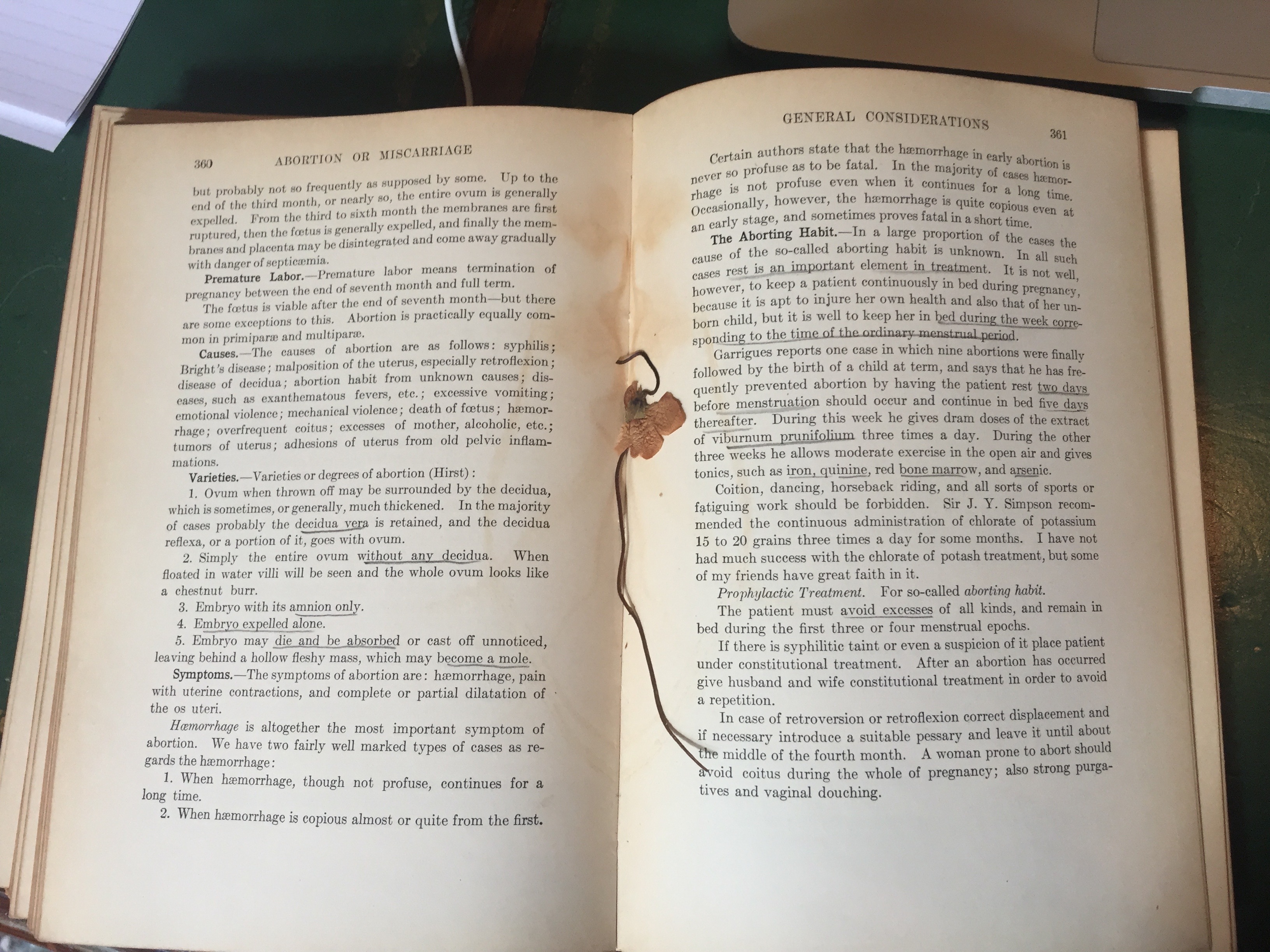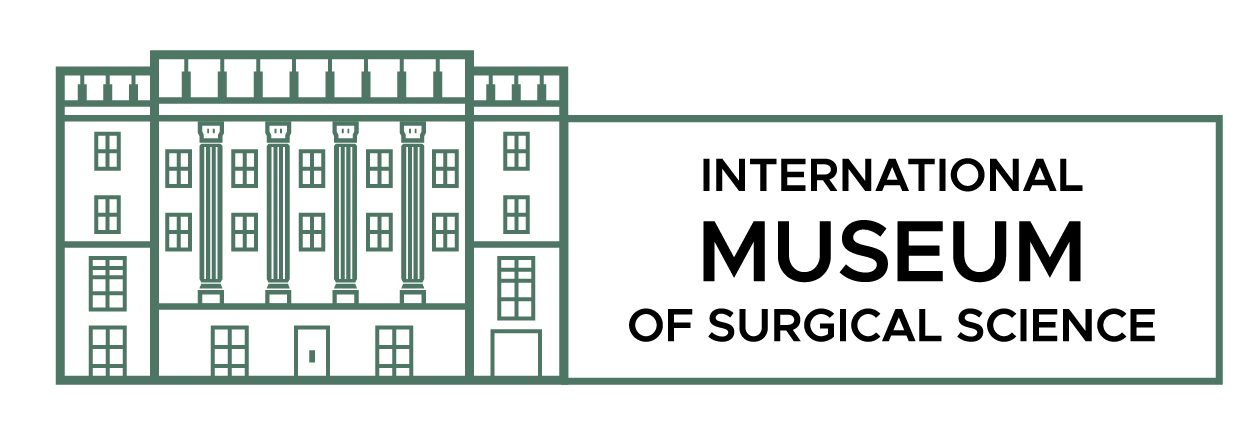This is Part III of the three-part essay, Sever and Suture: On the History and Future of Anatomical Dissection. Part I and Part II can be found on the Museum Blog.
Content Disclaimer:
The following article discusses potentially disturbing subject matter which may not be appropriate for all audiences. The views and opinions expressed in this essay are those of the authors and do not necessarily reflect the official policy or position of
the International Museum of Surgical Science.
Published by Tannaz Motevalli.
Part III: What Remains…

Pressed flower found in “A Text-book of Obstetrics” by Adam H. Wright (1905)
Pressed to harden, its liquids and juices, life-blood, sucked out and into the pages, leaving only water-marks. “Keep her in bed during the week corresponding to the time of the ordinary menstrual cycle” (Wright, 361.) She’s been dried out, thinned and crisp. Nestled between pages, she’s sitting in between this space, between being something precious and sacred or forgotten and discarded. Unclaimed. Her features no longer evident. No brilliant hue, no leaves, no roots. Unidentified.
I’m attempting to grapple with the loss. Loss of information, loss of intention, loss of subject, loss of story. The death of a beautiful thing is…complicated. It leaves me riddled with holes. It never belonged to me but I ache to know to whom. I feel detached and unsure of how to continue. I feel unstable, wounds left open in the hopes that air and time have the power to suture the space between knowing and not knowing.
The historical use of unconsented cadavers for medical exploration is fraught with the consistent disregard and objectification of what we consider to be sacred – human life and the body which contains it. I return to my original questions, does medicine grieve the people once housed by the bodies it dissects? Is there space for negotiation? Who will suture the cuts, mend the holes? Who will preserve the dignity of the dead?
I’m slightly left at a loss, not knowing the best possible ways to consider repairing this history. For me, the first thought turns to empathy and humanizing the historically dehumanized. What happens when the bodies once treated as parts to be used and discarded are now recognized as equally sacred beings they once were in life? What actions do this? According to Natalie Zarrelli, the 1960’s and ‘70s were the beginning of a shift in the treatment of medical cadavers, one that makes some small effort to repair. “In 1965 the first cadaver memorial ceremony was held in England, while American medical schools followed suit in the ‘70s” (Zarrelli, 2016). I’m not sure how much memorializing an individual does to repair. The most pressing question being, how much is the symbolic capable of undoing the past? If the symbolic is not enough, what do we do and how do we act to repair the damages?
This gets me thinking about the NAGPRA—Native American Graves Protection and Repatriation Act—an act of legislation passed in 1990 which maintains the “rights of Native Americans to certain human remains, funerary objects, sacred objects, and objects of cultural patrimony with which they are affiliated” (Babbit, 2011). For me, it seems that repatriation—the act of either compensating the family for one’s death or, more importantly, returning bodies—is the most vital part of this act. And to be clear, the repatriation of Native American human remains refers specifically to the collection of buried bodies in Natural History Museums. The Act does not include possible, yet unknown, human dissection for medical purposes of early Native Americans in the U.S., of which I have yet to find record. “In September of 2017, the remains of 24 native Alaskans excavated by a Smithsonian anthropologist were returned to their ancestral home for the first time in over nine decades” (Daley, 2017). The process to return these remains took roughly two-years and required intense collaboration between the Smithsonian and the Village of Igiugig, which is populated mostly by the indigenous Alaskan Yupik people. In this example I see two crucial steps being made: 1) releasing ownership and returning the dead bodies of the indigenous to their lands, and 2) building collaboration between the people oppressed with the institutions that represent and uphold oppression. To dehumanize a person, both in life and in death, means to silence them, relinquish them of their autonomy. To return autonomy to the people, or possibly the family of the dead, repairs the violations of the past ever so slightly—but does not erase. Since NAGPRA was passed in 1990, the Smithsonian alone has either repatriated or made available for repatriation over 6,100 human remains, 250,000 funerary objects and 1,400 sacred objects.
However, when it comes to the cadavers used in human dissection, there is little written about the remains. There is little done to humanize the bodies dissected in general, making conversations around repatriation unclear. The fate of a donated body, however, is in fact much brighter than I originally thought. According to a National Geographic article from 2016, once a medical school has finished dissecting a donated body, the body is cremated and the ashes are sent back to the families (McCall, 2016). It is important to point out that this process refers specifically to the willingly donated body, which includes bodies donated by families who cannot afford a funeral. And in many ways, for the family too poor to bury their loved one, this option has its benefits, but is still a choice made at least partially due to an unfortunate circumstance.
The need for dissectable bodies has always been great, but despite the ability to donate to science, society still seems to be behind:
There are more than 120 million registered organ donors in the United States, and an average of 79 people receive transplants each day, according to the U.S. Department of Health and Human Services. The federal government does not monitor whole body donations in the United States, but researchers estimate each year fewer than 20,000 Americans donate their bodies to medical research and training (McCall, 2016).
It is very clear that for some reason, full body donation carries some kind of a stigma making it significantly less popular to organ donations; but why? What informs this stigma? I cannot give a definitive answer, but it seems to me there are a few factors to consider. First, the history of cadaver acquisition is dark and questionable, which should have become clear throughout this essay. But, more importantly, the history of medicine, fraught with questions of ethics and morality, informs the way people trust healthcare. In a country like the United States where some people have to pay an arm and a leg simply to get quality health insurance, or simply go without, there is an undeniable sense of suspicion when the majority of the American public interact with the medical system. Second, the history I outline in Part II, and its subsequent evolution, is not widely known. So if someone has heard, even just a small bit, about body-snatching and grave-robbing, there’s no guarantee they understand the ways in which medical schools and other institutions of learning have actively made changes to overcome this history of blatant human rights violations. Lastly and most importantly, I believe that in the West, particularly within the U.S., conversations around death, loss, and grief have consistently been considered either taboo or far too private to be made public discourse; not to mention riddled with socio-political complications such as race, class, religious beliefs and upbringings, etc.
In the end, we need to have a larger conversation about how our bodies are and can be valued once we are gone. In regards to the popularity of organ donation over body donation, I too believe there is a misconception around how donated bodies vs. body parts are being used and which is considered more effective. Where an organ donation can potentially save the life of one individually desperately in need of a transplant, a body donation is capable of providing the necessary education for more than just one soon-to-be healthcare professional, eventually touching many more lives in ways both big and small. In no way, however, do I wish to pit these two extremely viable and extremely effective ways of using the body for the benefit of others, but I do simply want to point out that perhaps we aren’t seeing the clear benefits of both. Regardless of whether you donate your whole body or just organs, donating any part of one’s body is something that medical professionals will always be immensely grateful for as bodies and body parts are vital to the saving of other lives. And maybe one day, there will be enough willfully donated cadavers that there is not longer the need to use the unclaimed, unidentified, poor, and unknown. As for now, the future is unclear. But despite this lack of clarity, it seems to me as though truly genuine efforts are finally being made to improve the way medical cadavers are both acquired and used, which is a solid step in the right direction.
Sources:
Babbit, Thomaira. “NAGPRA as a Paradigm: The Historical Context and Meaning of the Native American Graves Protection and Repatriation Act in 2011” University of Central Oklahoma. 2011. http://www.se.edu/nas/files/2013/03/NAS-2011-Proceedings-Babbit.pdf
Daley, Jason. “In Emotional Homecoming, Smithsonian Repatriates 24 Sets of Human Remains.” Smithsonian Magazine. 2017. https://www.smithsonianmag.com/smart-news/smithsonian-repatriates-24-sets-human-remains-alaskan-community-180966927/
McCall, Matt. “The Secret Lives of Cadavers.” National Geographic. July 2016. https://news.nationalgeographic.com/2016/07/body-donation-cadavers-anatomy-medical-education/
Wright, Adam H. A Text-book of Obstetrics. D. Appleton and Company: Toronto, 1905.
Zarrelli, Natalie. “How the Medical Cadaver Finally Got the Respect it Deserves.” Atlas Obscura. May 2016. https://www.atlasobscura.com/articles/how-the-medical-cadaver-finally-got-the-respect-it-deserves
Tannaz Motevalli is a Chicago-based artist, writer, and researcher. She is the current Library Intern at the International Museum of Surgical Science. Her interests include performative writing, the intersections of personal and institutional/systemic histories, and archives as a form of storytelling.

